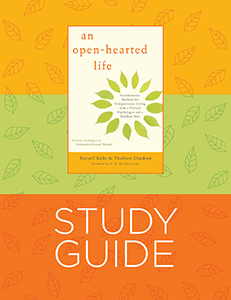A year of living with an open heart

A study guide for An Open-Hearted Life: Transformative Methods for Compassionate Living from a Clinical Psychologist and a Buddhist Nun by Venerable Thubten Chodron and Dr. Russell Kolts. The UK edition is entitled Living With an Open Heart: Cultivating Compassion in Everyday Life.
Foreword
It takes courage to cultivate compassion, and the going can get tough on your own. We’ve created this study guide as a resource for readers to reflect upon and share the joys and struggles of trying to live an open-hearted life. You might use this guide to spark conversation with loved ones, as a structure for an interest group that meets regularly, or simply to deepen your own practice.
We’d especially like to encourage readers to form discussion groups to delve into this wealth of material. As a classroom teacher, Karen has found small discussion groups invaluable for deepening knowledge based on mutual listening and open sharing of ideas. At Sravasti Abbey we take the same approach to learning the Dharma, with discussion groups being a staple of many of our retreat programs. All you need is a few people who want to commit to being happy, which shouldn’t be so hard to find!
There’s already a group of long-time Dharma friends in Seattle who have been meeting regularly to share their practice of compassion with each other. You can read their monthly reflections here.
If you’re up for it, we’d like to invite you to live one year with an open heart, whether it is by putting the reflections at the end of each chapter into practice each day, or by getting together with a regular discussion group. If you’d like to share your experiences of living with an open heart, please write us through the contact form.
May this guide inspire you to attempt and sustain a practice of compassion in your daily life and in your communities, for the long-term welfare of all sentient beings.
Karen Yeh and Thubten Damcho
Part I: Compassion: What it is, what it isn’t and why it’s worth cultivating
- Setting our motivation
- How does consciously cultivating a motivation affect your actions?
- What does it look like for you to include compassion in your motivation? Give some examples from your daily life.
- What is compassion and why do we need it?
- What is your experience of the two components involved in compassion? Is one component stronger for you than the other?
- How have you responded to challenges in your life with compassion, either for yourself or others?
- Compassion, interdependence and universal responsibility
- Consider a situation you have encountered on a personal, community or international level that demonstrates self-centeredness. What were the repercussions and how do you think the situation could have been changed for the better?
- “If we want to be happy ourselves, it is essential to care for the welfare of others.” Do you believe this to be true? Why or why not?
- Genuine compassion
- Give an example from your experience of how the same action can be done with compassion and with a self-centered motivation.
- What is a necessary ingredient for effective compassion and why?
- Abandoning misconceptions and making peace with our fears
- How is pity different from compassion? Give some examples to illustrate the difference.
- Shantideva gives the analogy of our hand pulling a thorn out of our foot to illustrate the relationship between compassion and respect. Think of some analogies that illustrate how compassion and respect work together.
- Courageous compassion
- Compare the differences between “idiot compassion” and courageous compassion.
- What habitual tendencies do you have when faced with the suffering of others? Do these habits support your practice of compassion or get in the way?
- Confusion about compassion
- What are three examples of confused compassion stated in this chapter?
- What are some things that we should consider before taking action to alleviate suffering we observe in others?
- A different kind of strength
- How do we avoid being trapped in our own or others’ emotions?
- Recount a situation in which you experienced fear. How might you cultivate confidence through habituation, understanding and new skills to overcome this fear?
Part II: The building blocks of compassion
- Mindful awareness
- How can mindful awareness help us when we experience powerful emotions such as anger, fear and/or anxiety?
- How does mindful awareness support our practice of compassion?
- Compassionate understanding of emotions
- Pick a disturbing emotion that often comes up for you and identify how it affects the different aspects of your mental experience.
- What are some ways you can shift your mind towards compassion when it is hijacked by a disturbing emotion?
- The power of optimism
- Think of examples of people who have been able to remain joyful despite terrible circumstances. What helped them to have an optimistic attitude?
- How is compassion for yourself different from being self-centered?
- Three types of emotion
- Consider how the framework of threat, drive and safeness systems works in your own personal experience. When the threat and drive systems come up for you, what are some ways you can shift them towards the safeness system?
- Working with unwanted thoughts and emotions
- Instead of blaming yourself or suppressing your negative thoughts, what are some ways other ways you can work with difficult emotions?
- Think about a time when you responded to a situation with self-blame. How might you use change your approach to the situation by practicing compassion?
- Becoming friends with ourselves
- What is the difference between self-criticism, arrogance and self-confidence? Give examples of how each of these attitudes manifest as thoughts in your mind.
- Compare the differences between treating yourself with respect and being self-indulgent by thinking of examples of this from your personal experience.
- “Follow your line”
- Russell refers to his experience of mountain biking and concentrating on his line of route as a way to circumvent obstacles. Come up with your unique analogy from personal experience that would be a good mantra to remember in the face of challenges in life.
- A healthy diet for the mind
- Recall your previous day and list the key things that filled your mind. Sort them into the categories of “healthy mental food” and “mental junk food.” Do you need to make any changes to your diet?
- Being responsible for our emotions
- What are some things that get in the way of you taking responsibility for your emotions?
- Think of a childhood experience that conditioned you to develop an emotional or behavioral response that is no longer helpful for you as an adult. How might compassion help you to change your assessment of that past experience?
- Beyond blame
- What are the assumptions you hold that cause anger and the tendency to blame to occur in your mind?
- What is an alternative perspective you might adopt, rather than framing a situation based on fault and blame?
- Establishing compassionate habits
- Take 10 minutes to generate a list of as many compassionate habits as you can think of. Get together with a friend and share your lists. Pick at least one habit for your friend to try, and let your friend do the same for you. After a week, check in with each other on the challenges and outcomes of your practice.
- Imagery and method acting: cultivating our compassionate selves
- Think about a compassionate quality that you would like to develop, and how a person whom you know embodies it. Try to imagine how this person might see the world such that it influences his or her behavior.
- Write a story or play out a scene in which you embody the compassionate quality that you would like to develop.
Part III: Cultivating compassion
- How to cultivate compassion
- Think of a time that was painful and difficult for you. What lessons did you learn from that period of suffering?
- What methods did you apply to work with your mind during that time? Which ones were helpful, and which ones were not?
- Equanimity
- Think of a person whom you have placed into all three categories of friend, enemy, and stranger at different times. What does this tell you about the nature of this person, and of your mind?
- The seven-point instruction of cause and effect
- Create a visual chart of the first three steps of instruction elucidated in this chapter.
- Love and compassion
- What do you consider to be happiness, and what do you think are its causes? Are you creating the causes for happiness in your life?
- What view can we adopt toward others and ourselves when we engage in misguided or unwholesome actions?
- Equalizing and exchanging self and others
- What are some reasons you give yourself for why your happiness or suffering matters more than the happiness or suffering of others? Does thinking in this way contribute to your happiness?
- The kindness of others
- Pick an ordinary object and create a mind-map to show the web of interdependent relationships centering on this object. Reflect upon the interdependent kindness required to bring just this one object into being.
- The disadvantages of self-centredness
- Do a review of your life and look at the times when you acted out of self-centeredness. Did those actions bring happiness or suffering?
- What would a healthy sense of balance look like in your life?
- “Rules of the universe”
- Get together with a friend, come up with your lists of your “rules of the universe,” and have a good laugh. Pick one of them and consider how you might work with it in a compassionate way.
- The benefits of cherishing others
- Do a review of your life and look at the times when you acted out of the wish to repay the kindness of others. Did those actions bring happiness or suffering?
- Exchanging self and others, and taking and giving
- How does the “taking and giving” meditation eradicate self-centredness?
- Share your personal experiences in going through the taking and giving reflection.
- Self-compassion and compassionate self-correction
- Think of a situation where you made a mistake and responded with self-criticism. How might you have responded with compassionate self-correction instead?
- What are some ways you can give yourself encouragement when you are struggling?
- Working with judgment and partiality
- What are some of the labels you place on yourself and others?
- Can you identify some of the conditioning around the ways that you judge yourself and others?
- Compassion and empathy
- Think of a time when someone tried to help you with the best of intentions, but was not able to understand what you needed. How did you feel at the time, and how do you think the other person felt?
- Compassionate thinking and mentalizing
- Come up with a table of keywords associated with compassionate thinking and threat-based thinking. An example to start:
Compassionate thinking
Threat-based thinking
Building connections between
peopleProving ourselves right Appreciate diversity
and differencesDefensive … … - Create a list of questions that might help you to understand the mental causes of suffering in yourself and others.
- Come up with a table of keywords associated with compassionate thinking and threat-based thinking. An example to start:
- The four immeasurables
- Group the following jumbled words on the right into the respective “close enemies” and “far enemy” for each of the four immeasurables stated in the left column.
Four Immeasurables:
Close enemies
Far Enemy
Love Partiality Jealousy
Personal distress Indifference
Anger Ill Will
Boredom Uncaring
Exaggerated grief
Clinging attachment
Cruelty Giddy excitementCompassion Empathetic joy Equanimity - How does each of these mental states manifest in your mind and affect your behavior?
- Group the following jumbled words on the right into the respective “close enemies” and “far enemy” for each of the four immeasurables stated in the left column.
- The importance of regular practice
- What are the benefits of establishing a regular mind-training practice? What might that look like for you?
- Make a list of the “reasons” that you give for not doing your practice. How might you address these reasons not to practice in a compassionate way?
Part IV: Compassion and connection
- Connecting with compassion
- Share a personal story of being in the presence of inspiring or compassionate figure(s). What are the qualities they exhibit, things they say or do that make them exude this sense of peace? Reflect on how you may be able to cultivate the same sort of peace that you have experienced.
- Reaching out with compassion
- Think of a time when you wanted to connect with others but acted in a way that brought about the opposite effect. How might you have reached out with compassion instead?
- Finding the best in other people
- Get together with a friend and make a list of each others’ positive traits. Or if you meet with a group, pass out post-its and write down at least one positive trait for each person, including yourself. Share the traits that others have written for each individual.
- Helping each other feel safe
- Think of some of the supportive relationships in your life. What types of attitudes and behaviors are present in those relationships?
- What are some ways in which you help others to feel safe and connected to you?
- Compassionate communication
- What does bringing compassion into your communication mean? Illustrate with a real-life situation.
- Describing situations accurately
- Watch a short video clip of a conflict between two people with a friend or as a group. Write down just the facts of what you saw and compare your descriptions.
- Identifying our feelings
- Give an example of sharing your evaluation, analysis, or interpretation of a situation. Consider you might rephrase that in a way that takes responsibility for your own feelings.
- What criteria do you use to evaluate whether your thoughts are accurate, inaccurate, harmful, or beneficial?
- Considering perceived threats and needs
- How are the needs identified in Maslow’s hierarchy different from demands?
- Identify the needs behind the preoccupations in your life.
- The importance of empathic listening
- What does empathic listening entail beyond assimilating information through our ears?
- What gets in the way of empathic listening for you?
- Offering empathy to ourselves and others
- Recall the four different ways of responding to an unpleasant situation. Apply each of them to a situation in your life and see what feelings come up for you with each type of response.
- Humor
- Think of a situation where your self-centeredness is at work, and see if you can use humor to help you gain a different perspective on the situation.
- What is one key consideration to take into account of when applying humor?
- The mindful-emotion traffic light
- Fill in the table below to see how the traffic light metaphor might help you understand your emotions.
Traffic light
signalEmotions felt
Remedying actions
(where applicable)Red Yellow Green
- Fill in the table below to see how the traffic light metaphor might help you understand your emotions.
- Making requests
- What makes a request effective and genuine, and how is such a request different from a demand?
- Think of a time when you made a request and someone turned you down. What feelings and needs came up for you, and how might you work with them in a compassionate way?
- Apologizing and forgiving
- What are some of the obstacles that hinder you from apologizing to or forgiving someone?
- How do apologizing and forgiving help us to release our hurt and anger?
- Giving positive feedback and praise
- Try out the “homework” that Venerable Chodron gives in her Buddhism classes, to praise at least one person to their face and another behind their back each day. What effect does that have on your mind?
- Come up with a list of non-verbal ways in which you can communicate our appreciation to others.
- Survival of the most cooperative
- In your respective communities (e.g., family, workplace, hobby group) identify the common good that everyone can cooperate towards.
- In what ways do you “compete” with yourself? What is your motivation for doing so?
- Compassion and attachment relationships
- Which of the three attachment styles—avoidant, anxious-ambivalent, and secure—is most applicable to you? How might you transform your way of dealing with others or yourself?
- Inspiring compassion in ourselves and others
- What is probably the best way to teach compassion to others and how might you gain facility in this method?
- Recall or brainstorm some ways in which you have been, or could become a secure attachment figure for others.
- The importance of consistency
- Why is compassion as a habit more important than compassion as a technique?
Part V: Bumps on the road
- Compassion and personal distress
- What is the difference between compassion and personal distress? Can you identify how these are different in your personal experience?
- What are some methods that you find effective for you to counteract personal distress?
- Compassion fatigue
- Have you experienced compassion fatigue, or seen it happen to others? What do you think are the factors that contribute to compassion fatigue?
- What helps you to recharge your batteries, and what doesn’t? What does this tell you about your needs?
- Removing partiality
- Reflect on the people you encounter in your life. Who are the people whom you find the most difficult to practice compassion toward? What are the mental barriers at work there and how might you remove them?
- Compassion gone awry
- What is the consequence of compassion gone awry?
- Being aware of our own feelings and needs is essential for compassionate action. Consider some instances of reverse compassion and examine the underlying intentions behind.
- Friends who give bad advice
- Draw a picture of the emotional friends who give you bad advice. Illustrate or reflect on how you might work with these friends with kindness and compassion.
- Fear of compassion, steadfastness, and thawing in our own time
- How can we connect with people who have a “fear of compassion?”
- How can we overcome this fear if we see it within ourselves?
- What are your thoughts on the phrase, “compassion is more about steadfastness than action?”
Part VI: Compassion in action
- Compassion as an antidote to low self-esteem
- How do you usually respond when you experience low self-esteem?
- How might you replace your habitual responses with compassion?
- Compassion as the antidote to the critical, judgmental mind
- What are some of the reasons you give to justify your critical, judgmental mind? How does this mind make you feel?
- What difficulties do you experience when trying to replace the judgmental mind with compassion?
- Slow things down and give them some space
- What are some reminders you can use to slow things down when you are in an emotionally charged situation?
- What does “giving things some space?” look like for you?
- Compassion and living ethically
- Consider the two aspects of ethical conduct: abandoning physical, verbal, and mental activities that are damaging to others and ourselves, and engaging in physical, verbal, and mental activities that benefit ourselves and others. Discuss practical examples of each aspect that you would like to practice incorporating in your life.
- Compassion, uncertainty, and listening to uncomfortable truths
- How do you usually respond to uncertainty and discomfort? How might you bring compassion into your habitual response?
- Seek out someone whose life seems very different from yours, and find out about his or her perspectives on a common issue on life (e.g., what they define as injustice, what makes a meaningful job, etc.). As a group, make a short video clip that presents these multitudes of perspectives.
- Small acts of compassion can have big results
- Commit to doing one small act of compassion daily. After a week, reflect on any changes in your state of mind or interactions with people around you.
- How compassion changes us
- Share a personal story on how you have noticed that compassion has changed you or others around you.
- Bringing compassion into every moment
- Make either a poster or design a postcard with one of the suggestions as a prompt or tagline. Consolidate your designs as a group and put them up as visual reminders to exercise compassion.
and be free from suffering and its causes.



